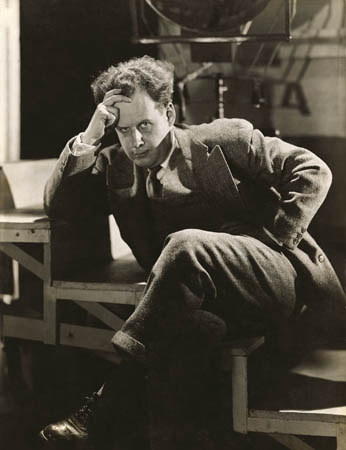fashion_icon:
Sergei Eisenstein
(1898 - 1948)
Sergei Eisenstein
(1898 - 1948)
 Famed Russian film maker and pivotal film theorist, Sergei Eisenstein’s confidently frumpy and cockeyed style transcended through his films, criticism, and personal fashion. Born in the Latvian capitol, Riga, in early 1898, Eisenstein’s style matured in an era that first hand witnessed European self annihilation in World Wars I and II. However, where most sensibilities of this era derive from the Western European perspective, primarily from France and England, Eisenstein’s fashion style epitomizes the new world consciousness of post-Revolutionary Russia.
Famed Russian film maker and pivotal film theorist, Sergei Eisenstein’s confidently frumpy and cockeyed style transcended through his films, criticism, and personal fashion. Born in the Latvian capitol, Riga, in early 1898, Eisenstein’s style matured in an era that first hand witnessed European self annihilation in World Wars I and II. However, where most sensibilities of this era derive from the Western European perspective, primarily from France and England, Eisenstein’s fashion style epitomizes the new world consciousness of post-Revolutionary Russia. As a teenager, Sergei joined the Red Army to support the Revolution. The stint in the army exposed Eisenstein with Japanese culture, leading to Eisenstein learning many kanji characters, studying Japanese pictorial style, and Kabuki theatre. Eisenstein’s look was, in many ways, East meets West. Western staples of menswear (the suit; the sweater) in exaggeratedly draped/wrapped silhouette – through double breasted suits or lavish shawl cardigans.
As a teenager, Sergei joined the Red Army to support the Revolution. The stint in the army exposed Eisenstein with Japanese culture, leading to Eisenstein learning many kanji characters, studying Japanese pictorial style, and Kabuki theatre. Eisenstein’s look was, in many ways, East meets West. Western staples of menswear (the suit; the sweater) in exaggeratedly draped/wrapped silhouette – through double breasted suits or lavish shawl cardigans. 1925 brought Eisenstein his most renowned success with the release of his film Battleship Potemkin. The method of montage construction was antithetical to what was commonly found in American features of the time. Instead of using editing to ease the flow of narrative storytelling, he made it an element of the film itself. What you saw on screen became as crucial as how it was assembled.
1925 brought Eisenstein his most renowned success with the release of his film Battleship Potemkin. The method of montage construction was antithetical to what was commonly found in American features of the time. Instead of using editing to ease the flow of narrative storytelling, he made it an element of the film itself. What you saw on screen became as crucial as how it was assembled. This could be applied to his personal style as well, representing the separates of Victorian menswear that can are mixed and match to build the constructed ensemble. Eisenstein’s looks also draw from explicitly Russian sources like the kosovorotka, and the sense of asymmetrical details.
This could be applied to his personal style as well, representing the separates of Victorian menswear that can are mixed and match to build the constructed ensemble. Eisenstein’s looks also draw from explicitly Russian sources like the kosovorotka, and the sense of asymmetrical details. Eisenstein personified the new-Russian aristocrat, in an era in which they were desperate to prove their worth to their Western counterparts. The style of the era, particularly the 30s, when most of his photos were taken, is certainly represented in the cut of his suits and casual apparel. But they also represent more than Old Movie Style, Eisenstein’s wardrobe contains elements of wit and nebbish aesthetic to it. The clothes are all awkward in a way, but together, they’re inspiring and unified, like the work of Ann Demeulemeester.
Eisenstein personified the new-Russian aristocrat, in an era in which they were desperate to prove their worth to their Western counterparts. The style of the era, particularly the 30s, when most of his photos were taken, is certainly represented in the cut of his suits and casual apparel. But they also represent more than Old Movie Style, Eisenstein’s wardrobe contains elements of wit and nebbish aesthetic to it. The clothes are all awkward in a way, but together, they’re inspiring and unified, like the work of Ann Demeulemeester. Eisenstein’s wardrobe embodies the sprit of the pre-WWII era, primarily that bigger is better. Wide cut lapels, London draped, double-breasted jackets and full cut trousers, all with the odd, disheveled quality.
Eisenstein’s wardrobe embodies the sprit of the pre-WWII era, primarily that bigger is better. Wide cut lapels, London draped, double-breasted jackets and full cut trousers, all with the odd, disheveled quality. The overall effect is effortless confident masculinity deeply rooted in conventionalism while also reworking the building blocks of the modern male wardrobe. Beyond the theory, Eisenstein’s specific style is just as inspiring. Square shouldered blazers, loosely draped jackets and sweaters, full-pleated, wide legged/Oxford Bag or tapered trousers, loosely constructed into a new look that isn’t too causal, preppy, or overwrought, yet perfectly individual.
The overall effect is effortless confident masculinity deeply rooted in conventionalism while also reworking the building blocks of the modern male wardrobe. Beyond the theory, Eisenstein’s specific style is just as inspiring. Square shouldered blazers, loosely draped jackets and sweaters, full-pleated, wide legged/Oxford Bag or tapered trousers, loosely constructed into a new look that isn’t too causal, preppy, or overwrought, yet perfectly individual.



0 comments